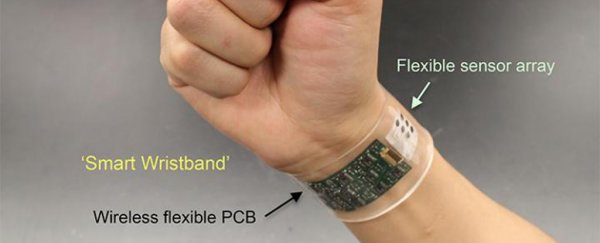There's no shortage of wearable gadgets designed to help you monitor your fitness, but scientists say these mainstream devices have so far been ignoring one valuable source of health data: your sweat.
Researchers in the US have developed what they claim is the first standalone electronic sensor that provides continuous, non-invasive monitoring of multiple biochemicals contained in perspiration. It might sound a little icky compared to a simple step-counter, but therein lies the value of the device.
"Human sweat contains physiologically rich information, thus making it an attractive body fluid for non-invasive wearable sensors," said Ali Javey, an electrical engineer and computer scientist at the University of California (UC Berkeley). "[We] have developed a fully integrated system that simultaneously and selectively measures multiple sweat analytes, and wirelessly transmits the processed data to a smartphone."
According to the researchers, the metabolites and electrolytes contained in human sweat say a lot about the health of a person, and could help replace invasive means of examining one's wellbeing.
"When studying the effects of exercise on human physiology, we typically take blood samples," said exercise physiologist George Brooks. "With this non-invasive technology, someday it may be possible to know what's going on physiologically without needle sticks or attaching little, disposable cups on you."
The prototype includes five sensors on an array connected to a flexible circuit board. The array of sensors measures metabolites (glucose and lactate) and electrolytes (sodium and potassium), and also monitors skin temperature, while the circuit board analyses the data collected and can transmit it to other devices.
The scientists say the sensor provides the basis of a new technology platform for sweat-based health monitors, and they don't just mean exercise accessories like Fitbits and Jawbones. The potential complexity of the array means it could also one day be used as a serious clinical tool to help physicians and scientists keep tabs on a range of biochemical secretions from patients, athletes, and perhaps even astronauts.
"We can easily shrink this device by integrating all the circuit functionalities into a single chip," said one of the team, Sam Emaminejad. "The number of biochemicals we target can also be ramped up so we can measure a lot of things at once. That makes large-scale clinical studies possible, which will help us better understand athletic performance and physiological responses to exercise."
The fact that the device can be worn constantly also means it's capable of collecting a much broader and less interrupted stream of health data, compared to the isolated measurements doctors might otherwise only be able to record during infrequent patient visits to their GP.
"We wanted to move from the kind of cumbersome equipment used in a clinic to a light, wearable device that could deliver continuous measurements," said Emaminejad.
The end goal of the research, which is reported in Nature, could be a device everybody wears that helps doctors monitor the health of whole communities at a time. From a privacy perspective, many might not want to take part, but the scientific possibilities could go a long way in advancing localised health efforts.
"With continuous, real-time monitoring of populations of people," said Davis, "we'll be able to mine the collected data for patterns that can guide clinically oriented investigations and deliver personalised medicine."

